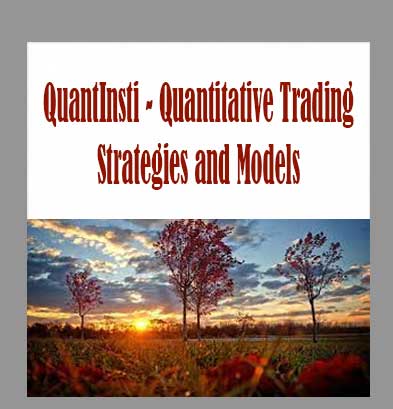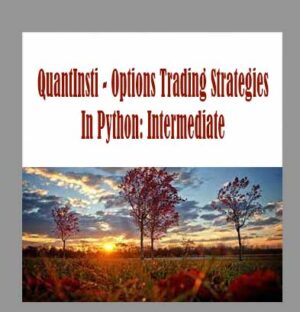Description
QuantInsti – Quantitative Trading Strategies and Models download, QuantInsti – Quantitative Trading Strategies and Models review, QuantInsti – Quantitative Trading Strategies and Models free
QuantInsti – Quantitative Trading Strategies and Models
Quantitative Trading Strategies and Models
Recommended course for those starting their journey in quantitative trading. It includes basic technical trading strategies, like the trend based strategy and the Bollinger bands strategy. These strategies can be traded on the live markets as well! You also learn the basics of Time Series Analysis, ARIMA and GARCH models, gamma scalping, options contracts and how to make delta-neutral portfolios.
LIVE TRADING
 Explain the difference between Quantitative trading and Technical trading
 Code 3 different trading strategies based on technical indicators
 Explain the econometric models such as ARIMA and GARCH
 Explain the BSM Options pricing model and the options’ greeks
 Apply and analyze strategies in the live markets without any installations or downloads
SKILLS COVERED
Time Series Analysis
Heteroskedasticity
Autoregressive Integrated Moving Average (ARIMA)
Generalized Autoregressive Conditional Heteroskedasticity(GARCH)
Black Scholes Model
Math Concepts
Functions
Statistics
Regression
Standard Deviation
Python
Iexfinance
Matplotlib
TA-Lib
Datetime
Quantrautil
PREREQUISITES
It is expected that you have some financial markets experience and understand terms like sell, buy, margin, entry, exit positions. Some familiarity with options and technical indicators will help you in better understanding of the concepts. If you want to be able to code strategies in Python, then experience to store, visualise and manage data using Pandas and DataFrame is required. These skills are covered in our course ‘Python for Trading’. However, you can do this course without any Python knowledge and replicate the models in spreadsheets or any other trading software language you are comfortable with.
SYLLABUS
Introduction to Quantitative Trading
This section defines the term ‘Quantitative Trading’ and discusses the components of a quantitative trading model.
Introduction to Quantitative Trading 3m 57s
Quantra Features and Guidance 3m 48s
Definition of Quantitative Trading 3m 49s
Components of a Quantitative Trading Model 2m
Properties of a Quantitative Trading Model 2m
Factors of High Frequency Trading 2m
Technical Trading Strategies
This section helps you understand concepts like Candlestick chart, support and resistance levels, absolute price change, and also explains technical indicators like Fibonacci Retracement, Stochastic Oscillator, and Williams %R. It also demonstrates the codes for Volume Reversal Strategy and Trend Based Strategy.
Technical Trading Strategies: Primer I 10m
Volume Reversals and Fibonacci Retracements 4m 45s
How to Use Jupyter Notebook? 1m 54s
Volume Reversal Strategy 7m
Frequently Asked Questions 10m
Getting Started with Python codes 5m
Importing Python Libraries 5m
Importing CSV Data 5m
Calculating Fibonacci Ratio 2m
Strategy Buy Signal using Williams % R indica 2m
Technical Trading Strategies: Primer II 10m
Introduction to Trend and Volatility 6m 29s
Trend Based Strategy 7m
Trimming the Data 5m
Calculating Strategy Returns 5m
Interpreting Volatility using Bollinger Band 2m
Generating a Strategy Buy Signal 2m
Analysing Price Breakouts with Bollinger Band 2m 56s
Bollinger Bands Strategy 7m
Standard Deviation of Returns 5m
Counting the Number of Trades 5m
Bollinger Band Fake Breakout 2m
Consistency in Breakouts 2m
Live Trading on Blueshift
This section will walk you through the steps involved in taking your trading strategy live. You will learn about backtesting and live trading platform, Blueshift. You will learn about code structure, various functions used to create a strategy and finally, paper or live trade on Blueshift.
Section Overview 2m 19s
Live Trading Overview 2m 41s
Vectorised vs Event Driven 2m
Process in Live Trading 2m
Real-Time Data Source 2m
Blueshift Code Structure 2m 57s
Important API Methods 10m
Schedule Strategy Logic 2m
Fetch Historical Data 2m
Place Orders 2m
Backtest and Live Trade on Blueshift 4m 5s
Additional Reading 10m
Blueshift Data FAQs 10m
Live Trading Template
Blueshift Live Trading Template
Paper/Live Trading Volume Reversal Strategy 10m
Paper/Live Trading Trend Based Strategy 10m
Paper/Live Trading Bollinger Bands Strategy 10m
FAQs for Live Trading on Blueshift 10m
Econometric Models
This section demonstrates the building of ARIMA and GARCH models. It also explains the concepts of Heteroskedasticity, Autocorrelation, and Log-linear trend.
Linear Regression Forecasting Equation 10m
Predicting the Dependent Variable ‘y’ 2m
Assumptions of LR 2m
Errors and Residuals in Linear Regression 10m
Impact of the Equation: SST = RSS + SSE 2m
Interpreting the Regression Score 2m
Introduction to Heteroskedasticity & Autocorr 5m 35s
Conditional/Unconditional Heteroskedasticity 2m
Positive and Negative Autocorrelation 2m
Time Series & Autoregressive Model 5m 45s
Log-Linear Trend Model equations 2m
Autoregressive model vs. Linear regression mo 2m
Understanding the ARIMA Model 5m 50s
Components of the ARIMA model 2m
Representing exponential growth with ARIMA mo 2m
Implementation of ARIMA Model 10m
Examples of ACF and PACF 10m
Lag in Autocorrelation function 2m
Correlation/Interdependence in ACF vs. PACF 2m
Predicting volatility using GARCH Model 5m 27s
Variance of Residuals in ARCH Model 2m
GARCH Prediction Variable 2m
Implementation of GARCH Model 10m
Quantitative Trading Strategies for Options Â
This section explains how to build a delta-neutral portfolio and trade using Greeks. It also explains the BSM model in Options.
Introduction to Options 10m
Call Option 2m
Put Option 2m
Black-Scholes-Merton Option Pricing model 10m
Factors influencing the BSM option pricing model 2m
Assumptions in BSM 2m
Introduction to Options Greeks 7m 28s
Calculating Delta of a Call option 2m
Impact of Volatility on Delta of an option 2m
Calculating Portfolio Delta 2m
Building a Delta Neutral portfolio with Gamma 7m 55s
Calculating PnL 2m
Using Gamma Scalping to Solve Negative Theta 6m 4s
Negative Gamma Exposure 2m
Positive Gamma Exposure 2m
Test on Quantitative Trading Strategies 10m
Run Codes Locally on Your Machine
Learn to install the Python environment in your local machine.
Python Installation Overview 2m 18s
Flow Diagram 10m
Install Anaconda on Windows 10m
Install Anaconda on Mac 10m
Know your Current Environment 2m
Troubleshooting Anaconda Installation Problems 10m
Creating a Python Environment 10m
Changing Environments 2m
Quantra Environment 2m
Troubleshooting Tips For Setting Up Environment 10m
How to Run Files in Downloadable Section? 10m
Troubleshooting For Running Files in Downloadable Section 10m
Summary
This contains of the course summary and downloadable strategy codes.
Course Recap 3m 57s
Python Codes and Data
ABOUT AUTHOR
QuantInsti®
QuantInsti is the world’s leading algorithmic and quantitative trading research & training institute with registered users in 190+ countries and territories. An initiative by founders of iRage, one of India’s top HFT firms, QuantInsti has been helping its users grow in this domain through its learning & financial applications based ecosystem for 10+ years.
WHY QUANTRA®?
Gain more in less time
Get taught by practitioners
Learn at your own pace
Get data & strategy models to practice on your own
REVIEWS
NISHAD SEERAJ – Data Scientist, Trinidad & Tobago
The course syllabus really appealed to me. It was more or less what I was looking for. Since I have a background in Finance, I was familiar with the theory concepts, I thought I might struggle with the programming part, but that did not happen because the course has a stepwise and detailed explanation of the codes. This is what convinced me to go ahead with the course. I also liked the Blueshift platform, although initially, the code for me was not the easiest thing to grasp, but line-by-line explanation really helped. It was a great bonus for me. All in all, this course has solid theory, solid practice exercises, and overall it was a great experience. After completing this course, I have a much better knowledge of programming compared to before.
ANIL BIYANI – Stock Market Trader, India
I learnt a lot. As an experienced trader, I felt I knew a lot. But after going through this course, I feel I am still a student and need to learn more. Thanks.
RAJAN VARGHESE – India
Quantitative Trading Strategies and Models gave me a basic understanding of the predictions methods and their various aspects. Also, the option delta, gamma, theta, and its relationship between the option price and the underlying price is very well explained.








